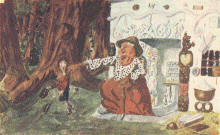Crone
This article possibly contains original research. (May 2015) |

In
In feminism
In
According to scholar Clarissa Pinkola Estés, the Crone is "the one who sees far, who looks into the spaces between the worlds and can literally see what is coming, what has been, and what is now and what underlies and stands behind many things. [...] The Crone represents the ability to see, more than just with one’s eyes alone, but to see with the heart’s eyes, with the soul’s eyes, through the eyes of the creative force and the animating force of the psyche."[4]
In patriarchal societies
As a
Etymology
As a noun, crone entered the English language around the year 1390, deriving from the Anglo-French word carogne (an insult), itself deriving from the Old North French charogne, caroigne, meaning a disagreeable woman (literally meaning "carrion"). Prior to the entrance of the word into English, the surname Hopcrone is recorded (around 1323–1324).[6]
In more modern usage, crone is also defined as a "woman who is venerated for experience, judgment, and wisdom."[7]
Examples
In
The
In the local folklore of Somerset in South West England, the Woman of the Mist is said to appear sometimes as a crone gathering sticks; sightings of her were reported as late as the 1950s.[11] In the Scottish Highlands tale "The Poor Brother and the Rich", a crone refuses to stay buried, until her son-in-law provides a generous wake, after which he becomes as wealthy as his more fortunate brother.[12]
In Cuban traditional folklore old women often appear as helpful characters, as in the tale of the sick man who cannot get well until he meets an old woman who advises him to wear the tunic of a man who is truly happy. According to writer Alma Flor Ada, "They tend to be the ones who keep the family together, who pass on the traditions, who know the remedies that would cure the different illnesses".[13]
See also
- Black Annis
- Fairy godmother
- Hag
- La Befana
- Queen (Snow White)
- The Witch (fairy tale)
- Wicca
- Wicked fairy godmother
- Witchcraft
References
- JSTOR 24322658.
- ProQuest 858604053.[page needed]
- ^ Payerle, Margaret (2016). "The Croning Ceremony". The Journal of Traditions & Beliefs. 3 (1).
- ^ OCLC 800011416.
- ISBN 978-1-317-04426-0.
- ISBN 978-0-06-270084-1.[page needed]
- ^ "crone". The American Heritage® Dictionary of the English Language (5th ed.). HarperCollins Publishers. 2022.
- ISBN 978-0-8131-2963-1.
- ISBN 978-0-8050-2701-3.
- ISBN 978-1-4766-7688-3.[page needed]
- ISBN 978-0-415-28601-5.
- OCLC 609004831.
- National Public Radio.
